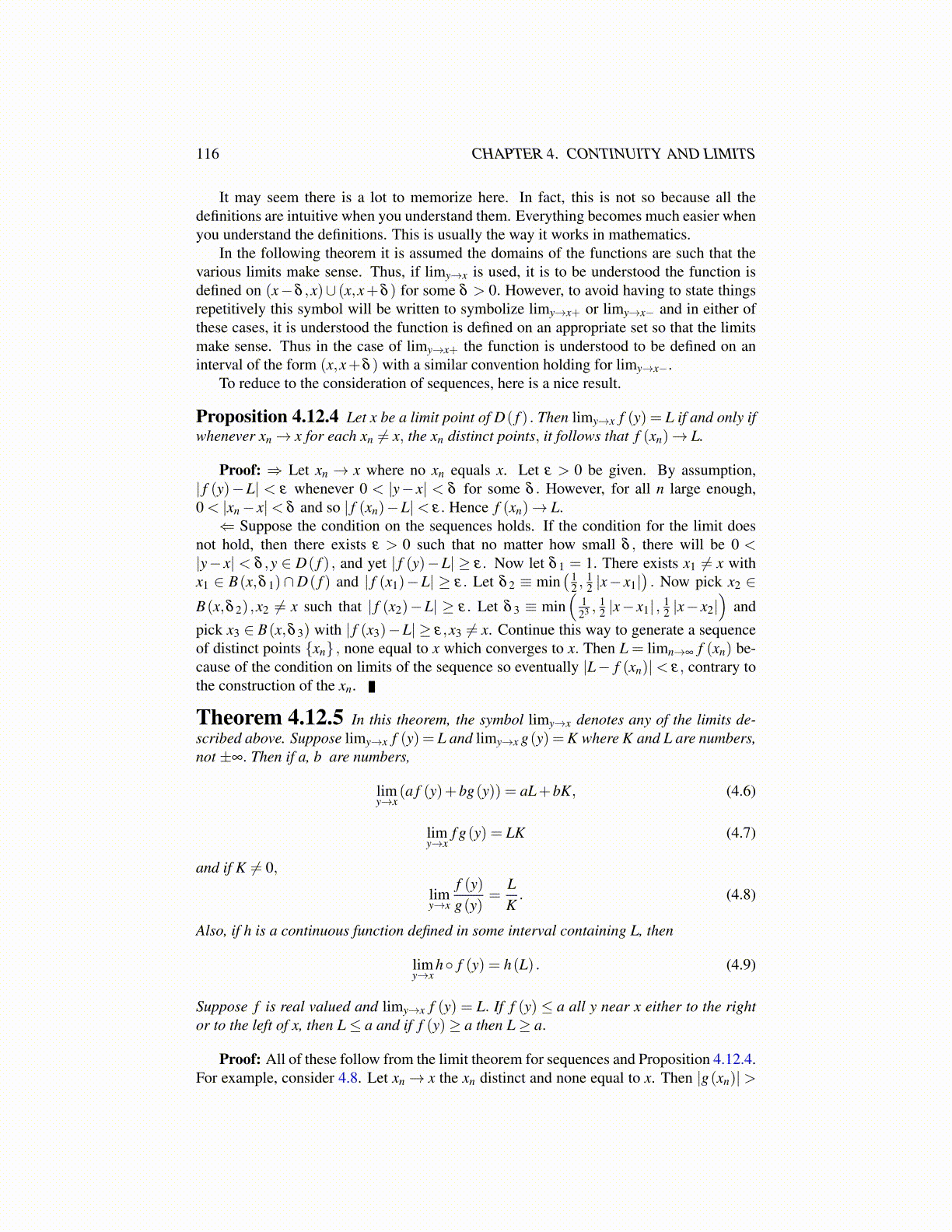
116 CHAPTER 4. CONTINUITY AND LIMITS
It may seem there is a lot to memorize here. In fact, this is not so because all thedefinitions are intuitive when you understand them. Everything becomes much easier whenyou understand the definitions. This is usually the way it works in mathematics.
In the following theorem it is assumed the domains of the functions are such that thevarious limits make sense. Thus, if limy→x is used, it is to be understood the function isdefined on (x−δ ,x)∪ (x,x+δ ) for some δ > 0. However, to avoid having to state thingsrepetitively this symbol will be written to symbolize limy→x+ or limy→x− and in either ofthese cases, it is understood the function is defined on an appropriate set so that the limitsmake sense. Thus in the case of limy→x+ the function is understood to be defined on aninterval of the form (x,x+δ ) with a similar convention holding for limy→x−.
To reduce to the consideration of sequences, here is a nice result.
Proposition 4.12.4 Let x be a limit point of D( f ) . Then limy→x f (y) = L if and only ifwhenever xn → x for each xn ̸= x, the xn distinct points, it follows that f (xn)→ L.
Proof: ⇒ Let xn → x where no xn equals x. Let ε > 0 be given. By assumption,| f (y)−L| < ε whenever 0 < |y− x| < δ for some δ . However, for all n large enough,0 < |xn − x|< δ and so | f (xn)−L|< ε. Hence f (xn)→ L.
⇐ Suppose the condition on the sequences holds. If the condition for the limit doesnot hold, then there exists ε > 0 such that no matter how small δ , there will be 0 <|y− x| < δ ,y ∈ D( f ) , and yet | f (y)−L| ≥ ε . Now let δ 1 = 1. There exists x1 ̸= x withx1 ∈ B(x,δ 1)∩D( f ) and | f (x1)−L| ≥ ε. Let δ 2 ≡ min
( 12 ,
12 |x− x1|
). Now pick x2 ∈
B(x,δ 2) ,x2 ̸= x such that | f (x2)−L| ≥ ε. Let δ 3 ≡ min(
123 ,
12 |x− x1| , 1
2 |x− x2|)
andpick x3 ∈ B(x,δ 3) with | f (x3)−L| ≥ ε,x3 ̸= x. Continue this way to generate a sequenceof distinct points {xn} , none equal to x which converges to x. Then L = limn→∞ f (xn) be-cause of the condition on limits of the sequence so eventually |L− f (xn)|< ε, contrary tothe construction of the xn.
Theorem 4.12.5 In this theorem, the symbol limy→x denotes any of the limits de-scribed above. Suppose limy→x f (y) = L and limy→x g(y) = K where K and L are numbers,not ±∞. Then if a, b are numbers,
limy→x
(a f (y)+bg(y)) = aL+bK, (4.6)
limy→x
f g(y) = LK (4.7)
and if K ̸= 0,
limy→x
f (y)g(y)
=LK. (4.8)
Also, if h is a continuous function defined in some interval containing L, then
limy→x
h◦ f (y) = h(L) . (4.9)
Suppose f is real valued and limy→x f (y) = L. If f (y) ≤ a all y near x either to the rightor to the left of x, then L ≤ a and if f (y)≥ a then L ≥ a.
Proof: All of these follow from the limit theorem for sequences and Proposition 4.12.4.For example, consider 4.8. Let xn → x the xn distinct and none equal to x. Then |g(xn)|>